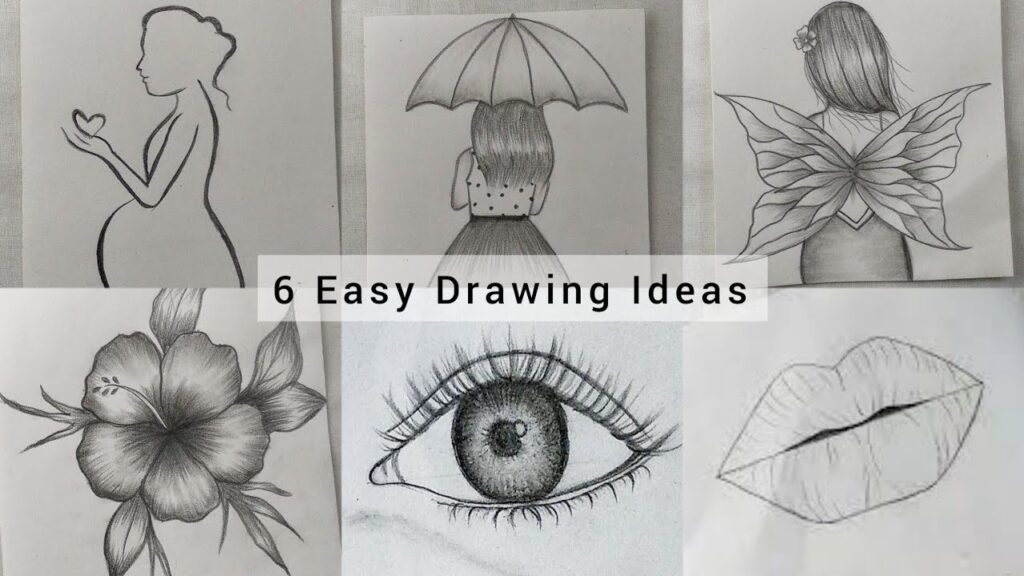Easy Drawing Ideas for Artists of All Skill Levels

Drawing is one of the most accessible and rewarding forms of artistic expression. Whether you’re a complete beginner or an experienced artist looking for inspiration, having a list of drawing ideas can help you improve your skills and stay creative. The beauty of drawing is that you don’t need expensive materials—just a simple pencil and paper can be enough to bring your imagination to life.
Exploring new ideas can challenge your creativity and refine your technique. If you’re feeling stuck or unsure of what to draw, this guide will provide you with a variety of easy drawing ideas that are fun, relaxing, and engaging for all skill levels.
Getting Started: Essential Drawing Tools
Before diving into the drawing ideas , having the right tools can make the drawing process more enjoyable. The most basic setup includes pencils, an eraser, and a sketchbook. Graphite pencils (ranging from HB to 6B) are great for sketching, while fine liners add detail to finished drawings. If you prefer colors, colored pencils or watercolors can enhance your sketches.
For digital artists, drawing tablets like Wacom, iPad Pro with Procreate, or XP-Pen offer intuitive ways to experiment with digital drawing. While traditional and digital tools differ, the fundamentals of sketching remain the same.
Simple Shapes and Patterns
If you’re new to drawing or just want to warm up, start with simple shapes. Circles, squares, and triangles may seem basic, but they are the foundation of more complex drawings. Practicing geometric shapes helps with hand control and improves line confidence.
Another great exercise is drawing mandalas or repetitive patterns. These not only help in improving symmetry but also serve as a relaxing, meditative practice. Shading these patterns can further enhance depth and visual interest.
Everyday Objects: Finding Inspiration Around You
One of the easiest ways to practice is by sketching objects around your home. Household items like mugs, books, lamps, or fruits offer excellent still-life subjects. These objects allow you to experiment with shading and proportions without requiring complex details.
To make things interesting, try drawing the same object from different angles. Changing perspectives can challenge your skills and improve your ability to capture depth and dimension.
Nature-Inspired Drawing Ideas
Nature provides endless inspiration for artists. Sketching leaves, flowers, trees, or simple landscapes is a great way to practice organic shapes and textures. A simple rose or sunflower sketch can be a great exercise in shading and detail.
If you enjoy drawing animals, start with easy subjects like butterflies, birds, or fish. These don’t require advanced anatomy knowledge but still provide a good challenge in creating natural shapes and movement.
For those who love seasonal themes, consider drawing autumn leaves in fall, snowflakes in winter, or beach waves in summer. These subjects help in experimenting with different moods and settings in your art.

Fun and Whimsical Doodles
Doodling is an excellent way to free your mind and explore creativity. Cartoon characters, chibi drawings, or abstract shapes are great options. Unlike realistic drawing, doodles don’t have strict rules, allowing for more personal expression.
You can also try personalized name art, quote lettering, or funny sketches. Doodling encourages artistic spontaneity and helps in developing a unique drawing style.
Portrait Sketching Made Easy
Portrait drawing might seem intimidating, but breaking it down into simple steps can make it more approachable. Start with basic facial features like eyes, nose, and lips before attempting a full portrait. Using guidelines can help maintain correct proportions.
Instead of diving straight into realism, try drawing cartoon-style faces or simple anime expressions. This makes the learning process easier while still improving your ability to capture emotions and facial details.
Creative Challenges to Improve Your Skills
One of the best ways to grow as an artist is by taking on challenges. These push you out of your comfort zone and help develop new skills. Here are a few fun exercises:
- One-line drawing challenge: Draw an object without lifting your pencil from the paper. This improves line confidence.
- Drawing with your non-dominant hand: A great exercise to enhance hand coordination and loosen up your style.
- Timed sketches: Set a timer for 5 or 10 minutes and try to capture a subject quickly. This improves speed and observation.
By regularly practicing these challenges, you can gradually see improvements in both creativity and technique.
Digital Drawing for Beginners
If you’re interested in digital art, starting with simple sketches can help build confidence. Free apps like Krita, Autodesk SketchBook, or Procreate (for iPads) offer beginner-friendly tools. Using basic brushes and layers allows more control and experimentation.
One major advantage of digital art is the ability to undo mistakes, experiment with different textures, and easily adjust colors. Whether you prefer traditional or digital, both mediums offer unique ways to express your creativity.
Tips to Stay Inspired and Keep Practicing
It’s natural to experience creative blocks, but finding ways to stay inspired can help. Keeping a daily sketchbook is one of the best habits an artist can develop. Even spending 10-15 minutes a day drawing something simple can lead to significant improvement over time.
Seeking inspiration from nature, movies, books, or art communities can also provide fresh ideas. Websites like Pinterest, Instagram, and DeviantArt showcase incredible artworks that can ignite creativity.
Another great way to stay motivated is by participating in online drawing challenges or joining local art groups. Engaging with other artists helps in learning new techniques and staying accountable for progress.
Conclusion
Drawing is an enjoyable and fulfilling skill that anyone can develop. Whether you’re sketching basic shapes, trying fun doodles, or improving portrait skills, there’s always something new to explore. The key to becoming a better artist is consistent practice, curiosity, and having fun with the process.
With these drawing ideas, you can break out of creative slumps and continuously refine your artistic abilities. No matter your experience level, picking up a pencil and sketching something new is always a step toward growth. So, grab your sketchbook and start creating today!
FAQs
1. What are some easy drawing ideas for beginners?
Beginners can start with simple shapes, everyday objects, doodles, or nature-inspired drawings like flowers and trees. Practicing these helps improve hand control and creativity.
2. How can I improve my drawing skills?
Consistent practice, experimenting with different subjects, and trying creative challenges like timed sketches or one-line drawings can significantly enhance drawing skills over time.
3. What are the best tools for beginners in drawing?
Basic tools include a pencil, eraser, and sketchbook. For those interested in digital art, beginner-friendly apps like Procreate, Krita, or Autodesk SketchBook are great starting points.
4. How do I overcome a creative block in drawing?
Looking at art for inspiration, exploring new themes, doodling freely, or participating in drawing challenges can help spark creativity and get past artistic slumps.
5. Can I learn to draw without any prior experience?
Yes! Drawing is a skill that improves with practice. Starting with simple sketches, studying proportions, and experimenting with different techniques can make learning easier and more enjoyable.

